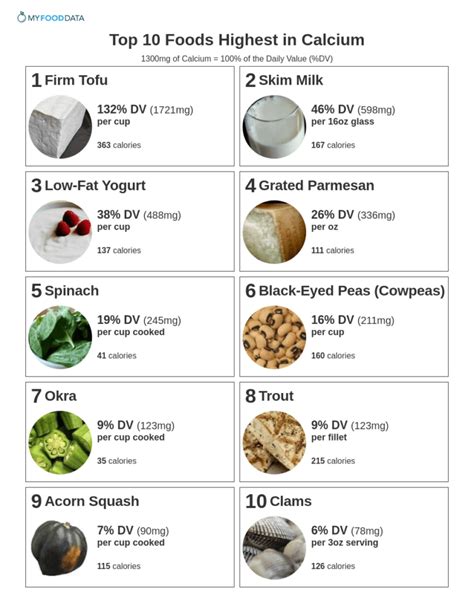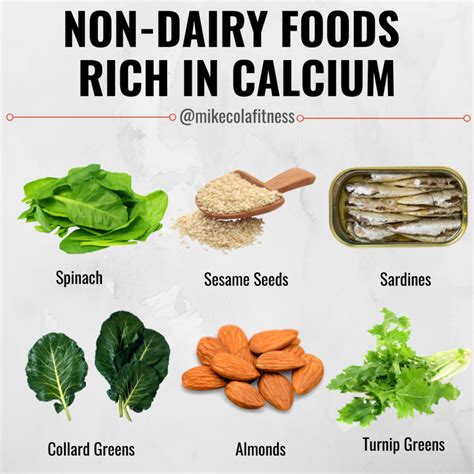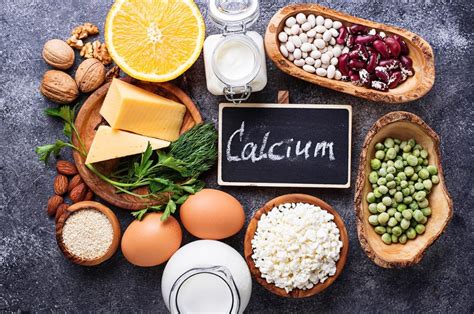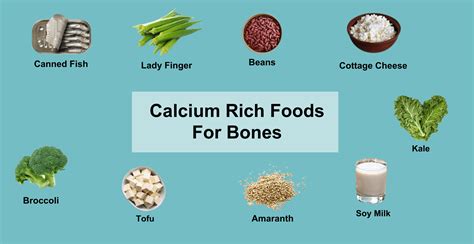Intro
Discover high calcium food sources, including dairy, leafy greens, and fortified foods, to support strong bones and teeth, with essential nutrients like vitamin D and phosphorus.
Calcium is an essential mineral that plays a vital role in building and maintaining strong bones and teeth, as well as supporting various bodily functions such as muscle function and nerve transmission. Adequate calcium intake is crucial for overall health, particularly during childhood, adolescence, and early adulthood when bones are still developing. Moreover, calcium deficiency can lead to a range of health problems, including osteoporosis, osteopenia, and increased risk of fractures. Fortunately, there are numerous high calcium food sources available, making it easy to incorporate this vital mineral into our diets.
The importance of calcium cannot be overstated, and it is essential to consume a balanced diet that includes a variety of calcium-rich foods. The recommended daily intake of calcium varies by age and sex, with adults requiring around 1,000 mg per day. However, many people fail to meet this requirement, particularly those who follow a vegan or vegetarian diet, as they often exclude dairy products, which are rich in calcium. Furthermore, some individuals may have a higher requirement for calcium due to certain medical conditions, such as celiac disease or Crohn's disease, which can impair calcium absorption.
In addition to its role in bone health, calcium also plays a crucial role in various bodily functions, including muscle contraction and relaxation, nerve transmission, and blood clotting. Moreover, calcium has been linked to several potential health benefits, including weight management, improved blood pressure, and reduced risk of certain diseases, such as colon cancer and kidney stones. With so many benefits associated with calcium, it is essential to prioritize calcium-rich foods in our diets and explore the various high calcium food sources available.
Introduction to High Calcium Food Sources

High calcium food sources can be broadly categorized into two groups: dairy products and non-dairy products. Dairy products, such as milk, cheese, and yogurt, are rich in calcium and are often considered the best sources of this mineral. However, non-dairy products, such as leafy greens, nuts, and seeds, can also provide significant amounts of calcium. In addition to these food groups, fortified foods, such as plant-based milk and cereals, can also contribute to our daily calcium intake.
Dairy Products as High Calcium Food Sources
Dairy products are some of the richest sources of calcium, with milk, cheese, and yogurt being among the best options. Milk, for example, contains around 300 mg of calcium per cup, while cheese can contain up to 200 mg per ounce. Yogurt is also an excellent source of calcium, with a single cup containing around 400 mg of this mineral. Other dairy products, such as butter and ice cream, also contain calcium, although in smaller amounts.Non-Dairy High Calcium Food Sources

Non-dairy high calcium food sources are an excellent option for those who follow a vegan or vegetarian diet or are lactose intolerant. Leafy greens, such as broccoli, kale, and spinach, are rich in calcium, with a single cup of cooked broccoli containing around 250 mg of this mineral. Nuts and seeds, such as almonds, sesame seeds, and chia seeds, are also good sources of calcium, with a single ounce of almonds containing around 80 mg of calcium. Other non-dairy high calcium food sources include tofu, edamame, and fortified plant-based milk.
Fortified Foods as High Calcium Food Sources
Fortified foods can also contribute to our daily calcium intake, particularly for those who follow a vegan or vegetarian diet. Plant-based milk, such as soy milk and almond milk, is often fortified with calcium, with a single cup containing around 300-400 mg of this mineral. Cereals, such as oatmeal and granola, can also be fortified with calcium, making them a good option for breakfast. Other fortified foods, such as orange juice and bread, may also contain calcium, although in smaller amounts.Benefits of High Calcium Food Sources

The benefits of high calcium food sources are numerous, with adequate calcium intake being essential for maintaining strong bones and teeth. Calcium also plays a crucial role in various bodily functions, including muscle contraction and relaxation, nerve transmission, and blood clotting. Moreover, high calcium food sources have been linked to several potential health benefits, including weight management, improved blood pressure, and reduced risk of certain diseases, such as colon cancer and kidney stones.
Practical Tips for Incorporating High Calcium Food Sources into Your Diet
Incorporating high calcium food sources into your diet can be easy and delicious. Here are some practical tips to get you started: * Start your day with a calcium-rich breakfast, such as oatmeal with milk or yogurt with granola. * Snack on nuts and seeds, such as almonds and sesame seeds, which are rich in calcium. * Incorporate leafy greens, such as broccoli and kale, into your meals, such as stir-fries and salads. * Use fortified plant-based milk instead of regular milk in your recipes. * Try new recipes that feature high calcium food sources, such as tofu and edamame.High Calcium Food Sources for Specific Dietary Needs

High calcium food sources can be tailored to meet specific dietary needs, such as vegan, vegetarian, and lactose intolerant diets. For example, vegan diets can include fortified plant-based milk, tofu, and edamame, while vegetarian diets can include dairy products, such as milk and cheese. Lactose intolerant diets can include lactose-free dairy products, such as lactose-free milk and cheese.
Common Mistakes to Avoid When Consuming High Calcium Food Sources
When consuming high calcium food sources, there are several common mistakes to avoid. These include: * Not consuming enough calcium-rich foods, leading to inadequate calcium intake. * Not varying your diet, leading to an over-reliance on a single food source. * Not considering individual calcium needs, such as increased requirements during pregnancy and lactation. * Not being aware of potential interactions between calcium and other nutrients, such as iron and zinc.Conclusion and Future Directions

In conclusion, high calcium food sources are essential for maintaining strong bones and teeth, as well as supporting various bodily functions. With a variety of dairy and non-dairy options available, it is easy to incorporate calcium-rich foods into our diets. By prioritizing high calcium food sources and being aware of individual calcium needs, we can maintain optimal health and reduce the risk of calcium-related disorders. As research continues to uncover the benefits of high calcium food sources, it is essential to stay informed and adapt our diets accordingly.
What are the best high calcium food sources?
+The best high calcium food sources include dairy products, such as milk, cheese, and yogurt, as well as non-dairy products, such as leafy greens, nuts, and seeds.
How much calcium do I need per day?
+The recommended daily intake of calcium varies by age and sex, with adults requiring around 1,000 mg per day.
Can I get enough calcium from non-dairy sources?
+Yes, non-dairy sources, such as fortified plant-based milk, leafy greens, and nuts, can provide significant amounts of calcium.
We hope this article has provided you with a comprehensive overview of high calcium food sources and their importance for maintaining optimal health. We invite you to share your thoughts and experiences with high calcium food sources in the comments below. If you have any further questions or topics you would like to discuss, please do not hesitate to reach out. Additionally, we encourage you to share this article with friends and family who may benefit from learning more about the importance of calcium in their diets.
